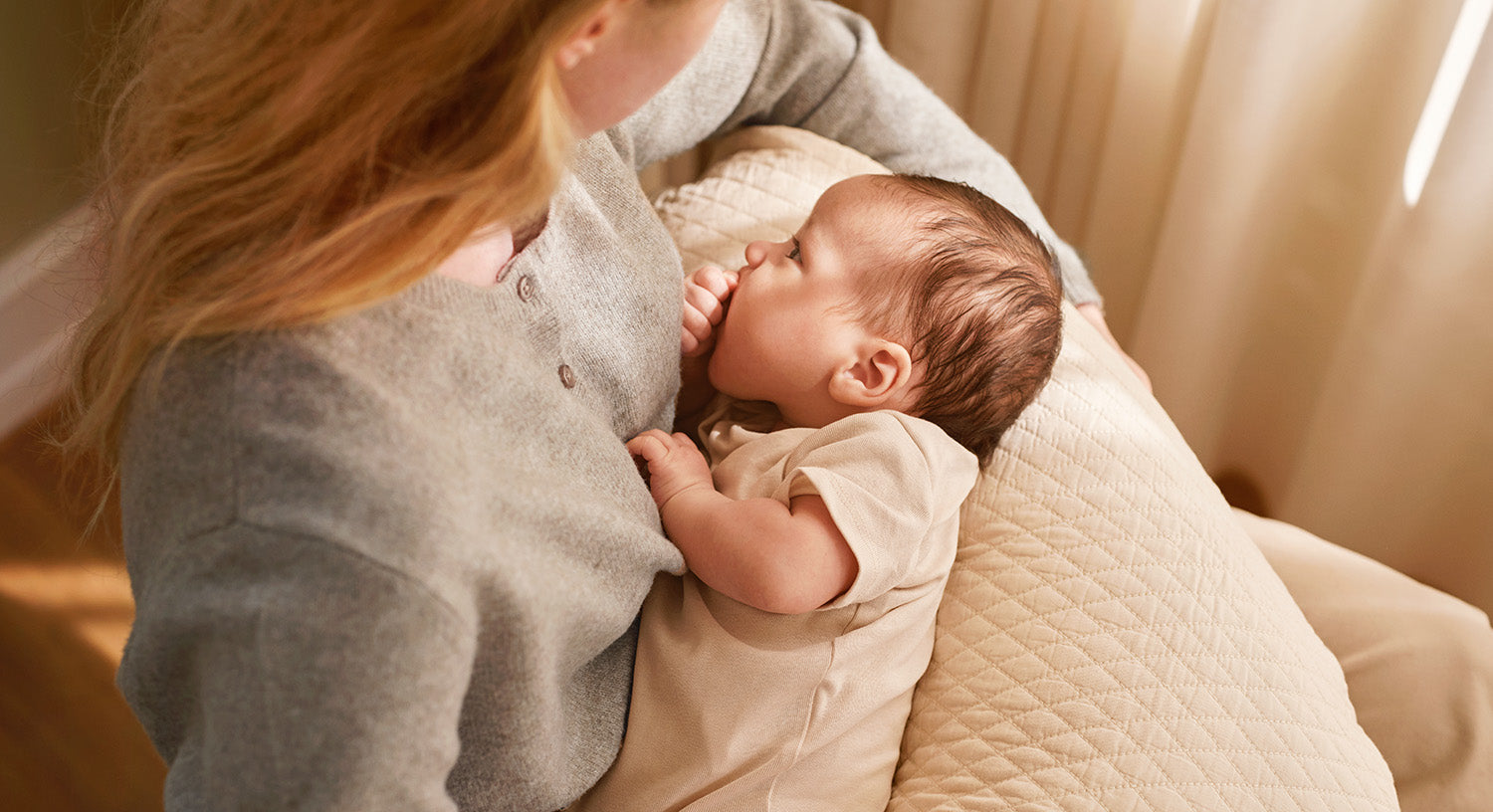


Your baby wakes up, cries and wants milk the second you even think about putting them down. You simply can't figure out what you are doing wrong. Is there something wrong? Am I doing it all wrong? And why does my baby keep waking up? Am I not producing enough milk, or is the little one in pain?
Thoughts and worries can be all-consuming when you are caring for a newborn. Especially, if you find that your baby won't just eat and take a long nap.
Don’t worry about worrying! These worries are perfectly normal and we all have them. In this article, lactation specialist, Birgitte Kasse, and sleep counsellor, Mia Bjørnfort from Sovende Børn explain the possible reasons why your baby wants to be in your arms and breastfeed – non-stop!
Disclaimer: This article describes babies who have difficulty calming down anywhere but in their caregivers’ arms. Parents of babies displaying this behaviour are often worried that there is something wrong with their baby, or that they are doing something wrong that is causing the baby not to be able to calm down, for example, in a bed or a cot. They may feel pressured to “teach the baby to fall asleep independently”, despite the baby’s insistent need for close human contact. If you have a baby who easily finds peace and quiet outside of your arms, this is also quite normal – and some babies can swing back and forth between the two, from time to time or even on the same day.
A human baby is a mammal and a primate
Humans are mammals and primates. It's biology – and it's not something you can just change. In other words, it is in our nature.
However, we are indeed exceptionally underdeveloped mammals and primates. We are neither capable of keeping up with our mother nor hanging on to her. In turn, she can’t leave us in a den or a nest to go hunting for food, either, as we would die of starvation and a lack of warmth and human contact before she returned.
Human babies are actually most similar to kangaroos – we are just not equipped with a pouch for the baby to grow big and strong in. After all, human babies aren't actually ready for life outside the womb – and keeping that information in mind can make a huge difference to your understanding of common baby behaviour.
The 4th trimester: The baby is not fully developed at birth
Perhaps you’ve already heard of “the 4th trimester”? This is a way of describing the fact that the human child is born before it is fully developed.
The baby completes its development outside the womb, which is often referred to as “exterogestation” (“outside the womb“). In fact, human babies are helpless little weaklings in need of constant milk, warmth and care – hence the comparison with kangaroos. Babies need a sort of "external womb" to finish developing, just like the kangaroo's pouch.

An "external womb", by definition, must have some of the same qualities as a real womb:
- Constant access to food
- Constant access to physical touch/contact
- Constant access to hearing, smelling, feeling the baby’s mother (or another known caregiver)
- Constant rocking motion.
It is very easy to see how a chest, one or two arms, a baby wrap or a baby hammock are reminiscent of the baby's time in the womb, and can meet some of the same needs.
5th and 6th "trimester": You are the safe base
By the end of the 4th trimester, when the baby is about 3-4 months old, the baby is ready to actively participate in life outside the womb. The child can begin to see properly, turns their attention to the world and begins to cling to the adults around them. In addition, the baby now often sits like a fixture on their caregiver's hip, supported by a strong adult arm.
The little arms and legs also wrap tightly around the adult's body while the baby is actively reaching out, pointing and exploring the world. The world can be experienced from a safe and secure base, which is not at all a bad place to be. However, the baby is still neurologically and motorically underdeveloped compared to other mammals and/or primates, and it will take a good amount of time before the baby is ready to move out into the world on their own.
By around 9 months, babies will usually have learned to crawl, elbow or toddle around on their own. This is also often described as "9 months in and 9 months out". However, your baby will still be constantly turning towards you and returning to your safe chest and arms for years to come – the world is a big place and can seem really overwhelming.
Attachment behaviour: When the baby seeks to come back to you
When you repeatedly experience periods where your baby seeks your embrace as well as your milk, whether it comes in the form of breasts or in a feeding bottle, it is because you, your body and your loving arms are truly your baby’s “home”. Just like the baby kangaroo that crawls into the pouch when the world gets just a touch too big, your baby seeks to be back in your arms.
Through your presence and loving care during the baby's first months of life, you have proved to be the safe base that provides peace, security, and nice, warm milk. Your baby has bonded with you through your shared experiences, where you have listened to your baby’s needs and met them as best you could. You have shown that you are there for your baby and are with your baby day and night, whether your baby is having a hard time or a great time.
When your baby seeks you out, it’s called “attachment behaviour“, whether it takes the form of smiling and playing to get your attention, or crying and reaching out until they are back in your safe embrace.
In most cases, when your baby wants to sleep on you and possibly breastfeed constantly, it is because they are going through a difficult time and are looking for the safety and care you so lovingly provide. The baby may be ill, going through something difficult, such as starting in a nursery, or may be simply undergoing a leap of physical or mental development, such as having discovered their hands.
Either way, you can trust that your baby's behaviour is not only natural, but also reflects a huge declaration of love for you, and is clear proof of the impact of all the care you give your baby each and every day.

What should you do when your baby's only happy place is in your arms and breastfeeding seems like a constant need?
It can feel really overwhelming when your baby only wants to be with you or your partner. However, it is important to know that it is entirely normal for your baby to need to be held and fed frequently.
Some tips on how to deal with periods of need for constant contact:
- Acceptance: We know, that this is the hardest part, but it will get easier (or less difficult) if you know and stick to the fact that it really IS normal baby behaviour.
- Tools: Maybe a baby hammock, a baby wrap or a baby carrier can help you provide the constant contact and/or rocking motion that your baby needs
- Sleep with the baby at your breast: You can bring your baby to bed so you can sleep together and breastfeed lying down. This just requires a bit of preparation and knowledge.
- Make yourself comfortable: Find a series or a book to enjoy while you sit/lie with your baby. Prepare a "packed lunch" and a water bottle for yourself for the hours you might be spending on the sofa/in bed.
- Do you need to get out? A carrier can help you get out of the house even if your baby craves constant physical contact. Maybe with a little good will you can zip your or your partner's sweater/jacket over the baby so the baby is still close to you without you having too wear layers of clothing?
- Are you skin-satiated and in need of a break? It can be really challenging to say no and set a personal boundary if it means your baby gets upset. Sometimes, however, not much of a "break" is needed – and, in most cases, the baby can be calmed down fairly acceptably in someone else's arms, as long as they are able to stay calm even if your baby is upset.
Do you doubt whether your milk supply is adequate because your baby wants to breastfeed all the time?
It is natural to have concerns about "not enough milk" if your baby is constantly seeking your breast. However, seeking your breast is not only about the need for milk, but also reflects the baby's need for reassurance, which is met at the breast, whether or not your baby is actively sucking.
Some babies eat large meals, whilst others are more into snacking. Some breasts can have a lot of milk in them at a time, while others only contain a little milk at any one time. In fact, it is the total intake over the course of 24 hours that matters, not whether your baby gets the milk split between 8 or 16 meals.
Otherwise, if you have a good, pain-free breastfeeding experience, baby latches easily on and fills their nappy, and you can clearly hear and see baby getting plenty of milk, it is safe to let go of your fear and trust your baby’s signals to go to the breast.
Worried your milk is “undernourishing” because your baby wants to eat all the time? Let’s quickly dispel that myth: There is no such thing as ‘undernourishing’ breast milk – ALL breast milk is good breast milk. What really matters is the amount of milk the baby gets in a 24-hour period.
Note: Do you have pain or sores? Does your baby latch onto the breast and then leave it? Or, does your baby have difficulty drinking from a feeding bottle? Does your baby have milk running out of the corner of their mouth or tend to swallow a lot of air? If so, it might be a good idea to get a lactation counsellor/health visitor to assist you.
For some babies, the need to “stay on you” arises in periods of days or weeks, whilst for other babies it is more or less a constant state for the first few months. Yet, some parents never go through this experience, which shows the significant variation in babies’ unique needs, just as we adults have different needs, too.




































